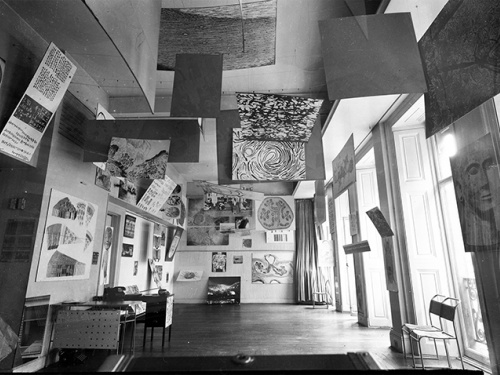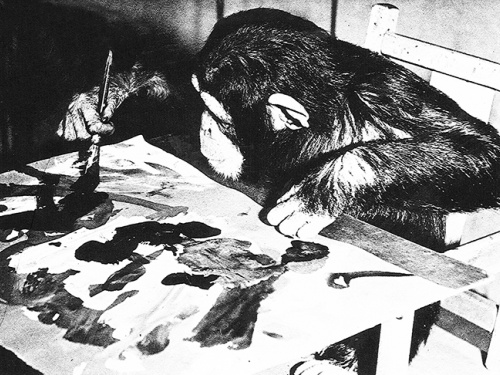Roland Penrose: The Life of a Surrealist
In this extract from his biography of ICA co-founder Roland Penrose, James King explores the life of a quiet rebel: his ambitions for the ICA and how he changed the landscape of contemporary art.
Roland Penrose: The Life of a Surrealist is published by Edinburgh University Press.
Although he kept in touch with the ICA, Roland had lost touch with its day-to-day activities during his Picasso years. He had expected Herbert Read to carry on in his place, but when Read died in 1968 Roland felt duty-bound to rekindle his formerly close relationship with the Institute. Finding new quarters for the ICA – and raising funds to accomplish this – became Roland’s preoccupation. The lease on the old premises on Dover Street was up and the decision was made to move to a Nash mansion on Carlton House Terrace, on the Mall. Roland and many others felt that Dover Street had lost steam. Rather than being a place devoted to innovation, they argued, it had assumed the air of a cozy, genteel club.
Lord Goodman, the chairman of the Arts Council, favoured the move, but £500,000 had to be raised to make it happen. Goodman made it clear that the Arts Council would not give a block grant unless contemporary artists supported this initiative. Sotheby’s waived its fees for fund-raising auctions held on 23 June 1966 and 12 December 1967. Lee gave Braque’s cubist La Mandore to the first auction to which, among others, Bacon, Hepworth, Man Ray, Miró, Nicholson and Picasso donated. Roland gave Picasso’s Le Crayon qui Parle and purchased Chadwick’s Dancers II.
"[Penrose] was externally a member of the Establishment...yet internally still a renegade, a rebel."
For the second auction, he intended to donate Femme nue couchée au soleil sur la plage, the first work he had acquired by Picasso. He asked Joanna Drew to collect the picture from the Hornton Street flat. She was just leaving when Lee arrived and asked Drew what she was up to. When told, she replied: "If that goes, I go!" Wisely, Drew put down the canvas and fled. The two auctions raised about £115,000, which Roland topped up with a further £20,000.
Tony Penrose was flabbergasted when he attended the opening party at the new ICA in April 1968 which featured Mark Boyle’s Sensual Laboratory and Ginger Johnson’s African Drummers: "If I had landed on another planet it would have been less of a jolt: the cavernous gallery was pulsing with the brain-pulping sound of an African rock band. The walls reflected ever-changing amorphous psychedelic colour patches from a series of ingenious lanterns. Various “happenings” were staged around the gallery, some erotic, others just bewildering. It was hot, dark and jammed tight with merrymakers in the trendiest of costumes who danced, drank and enjoyed the sight of each other as much as the “happenings”. Indeed it was a great event, but it was so un-Roland with its noise, garishness and raw licentiousness."
What soon became apparent to Roland was that the new ICA was not the ICA he had helped found. The Dover Street quarters may have been cramped, but they had been a place where artists could meet and actually talk about their work. The new place, with its large gallery, cinema and café, had cost so much that it brought in an entirely new segment of support – "closer", as Roland observed, "to the strongholds of finance and industry in the city and therefore possibly further from the intellectual pioneers who had still understood the purpose of the ICA".
Desmond Morris, who had organised the highly successful show of Congo’s art in the spring of 1957 at the ICA, became its director in 1967. He resigned within a year, after his book The Naked Ape became an overnight success. Read told Roland: "It shows it pays to write on Apes rather than Art!"
"Tony Penrose was flabbergasted when he attended the opening party at the new ICA in April 1968: "If I had landed on another planet it would have been less of a jolt"."
Roland strongly backed Morris as director because he felt that the younger man was a genuine ‘wild man’ who could transform the ICA in a new, meaningful way. In recalling his time as director, Morris recollected the only sharp words directed at him by Roland: "I remember going down the street in London with him once and mentioning a scandal in the news about someone’s sex life. He turned to me quite angrily and said: “What people do in the privacy of their own homes is their own business.” It was the only time he was ever sharp with me. I said he’d misunderstood me, and he said I had spoken as though I was being disparaging."
By 1968, the old ways of operating the ICA had completely disappeared. In the 1950s, Roland and Peter Watson had kept the ICA from going under by means of frequent infusions of cash. After 1964, when the Labour government came into power, the Arts Council was supportive. Essentially the ICA, in its first incarnation, had been run along the lines of a private gallery, but with public funding. That cozy situation changed with the move to the Mall: its scale of operation meant that it needed a great deal more money for basic operating expenses, and that increased funding became more open to scrutiny. It had also become incredibly easy, under the traditional ways in which business at the ICA had been conducted, to run up a deficit quickly. Some members of the Arts Council felt that issues which were international in scope should be under the control of the British Council. The Arts Council, which did not wish to relinquish control to the BC, became more stringent in its overseeing of ICA spending.
"Roland strongly backed [Desmond] Morris as director because he felt that the younger man was a genuine ‘wild man’ who could transform the ICA."
The new director, Mike Kustow, came from the Royal Shakespeare Company, where he had established Theatreground, a mobile theatre unit. He was also a fervent CND supporter. His vision of the ICA was extremely idealistic: "It needed to become a workshop for the new, a centre for innovation, which, he felt, both individuals and society thirsted for; he wanted to make it a kind of alchemical alembic, in which the base matter of confusion and disintegrated experience was transmuted, healed, transformed into higher matter, in which problems became material for illumination and play." Yet, as he admitted, he never discovered the correct ‘strategy’ for such magic.
Kustow found Roland a very amiable but divided person: in conversation he was "full of reminiscences of his youth in Paris with Picasso, his wild times with Éluard and the Surrealists, his flouting of moral and aesthetic conventions in pre-war Britain. The Chairman, now knighted for his services to art, told these tales of outrage and challenge, of ventures into the irrational and the unconscious, in an endearingly incongruous style, the style of “a very perfect gentleman”, externally a member of the Establishment, at home, despite his defiantly flamboyant ties, in the Athenaeum, yet internally still a renegade, a rebel." ■
Roland Penrose: The Life of a Surrealist by James King is published by Edinburgh University Press at £30.00, and the author will be talking about his new book at the Edinburgh International Book Festival, 21 August 2016, 11am-12noon
This article is posted in: Articles, Blog, News
Tagged with: ICA History, From the Archive, Archive, Archives, Roland Penrose, Picasso, James King, Book, books, Book Extract, Surrealism, The Surrealists

/index.jpg)






